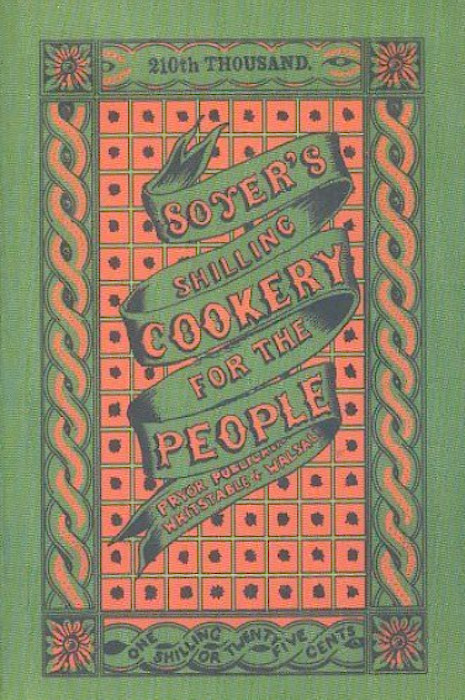
Alexis Soyer, from the frontispiece to his famous cookery book.
Alexis Benoît Soyer was born on 4 February 1810 at Meaux-en-Brie on the Marne in France. He was the youngest son of Emery Roch Alexis Soyer, a grocer, and his wife Marie Chamberlan. The couple had five sons: Alexis was the youngest. However two of the sons — Paul and Rene — died. When Alexis was born, Marie thought he was a blessing, therefore she wanted him to enter the Church. However, he did not choose that calling in life.
Between 1821 and 1826 he served as apprentice to a cook at Grignon, near Versailles and then was employed by the Boulevard des Italiens, where he worked for about three years, soon becoming chief cook over twelve men. In June 1830 he was second cook to Prince Polignac at the French Foreign Office, but left France during the July revolution (1830) and in 1831 he accepted employment in the London kitchen of the Duke of Cambridge. Subsequently he worked for the Duke of Sutherland, the Marquis of Waterford, William Lloyd of Aston Hall, Oswestry, and the Marquis of Ailsa at Isleworth. In 1837 he was appointed as chef to the Reform Club, London. On the day of Queen Victoria's coronation (28 June 1838) he prepared a breakfast for two thousand guests at the club.
In February 1847 Soyer wrote letters to the public press about the famine in Ireland, and in April he was appointed by the government to go to Dublin where he built and opened kitchens from where he sold soup and meat at half the usual cost. While there, he published a sixpenny book, Soyer's Charitable Cookery, giving part of the proceeds to various charities.
In 1849 he began to market his 'magic stove' with which food could be cooked on the table. It proved to be very successful. In May 1850 he resigned from his post as chef at the Reform Club, where his salary and fees brought him in almost £1,000 a year. In May 1851 he opened Gore House, Kensington, as a restaurant, hoping that the Great Exhibition in Hyde Park would bring him numerous customers. Although the restaurant was well patronised, the venture resulted in a loss of £7,000.

The cover of Soyer's Shilling Cookery. A small image of this was originally shared with the Victorian Web by Alan Pryor (Publisher) of Whitstable, Kent, UK, who retained the copyright for it. At the time of writing, the book was available from him at £5.95 post free.
On 2 February 1855 he wrote to The Times offering to go to the Crimea at his own expense to advise on the cooking for the army there. He began by revising the diet sheets for the hospitals at Scutari and Constantinople. In two visits to Balaklava he, Florence Nightingale and the medical staff reorganised the provisioning of the hospitals; he also began to cook for the fourth division of the army. On 3 May 1857 he returned to London, and on 18 March 1858 he lectured at the United Service Institution on cooking for the army and navy. He also built a model kitchen at the Wellington Barracks, London.
He died on 5 August 1858 at St. John's Wood, London and was buried on 11 August in Kensal Green cemetery. Soyer wrote many cookery books including A Shilling Cookery Book for the People (1855), Soyer's Culinary Campaign (1857) and Instructions for Military Hospitals (1860).
I am grateful to Frank Clement-Lorford for correcting some factual errors that originally appeared on this page and for supplying further information [MB]. Click on both images to enlarge them [JB].
Bibliography
Soyer, Alexis. A shilling cookery for the people : embracing an entirely new system of plain cookery and domestic economy. London: Routledge, 1858. Internet Archive. Contributed by the University of Leeds Library. Web. 4 February 2018.
Image added 4 February 2018